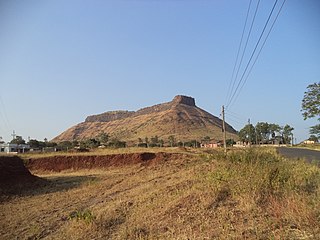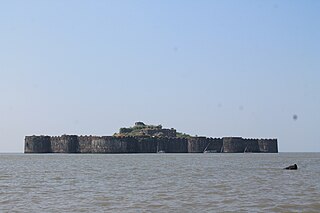
Bajirao I was the 7th and greatest Peshwa of the Maratha Confederacy. He, after Shivaji, is considered to be the most charismatic and dynamic leader in Maratha history. He was just twenty years old and already had a reputation for rapid decisions and a passion for military adventure.

Sambhaji, also known as Shambhuraje, was the second Chhatrapati of the Maratha Kingdom, ruling from 1681 to 1689. He was the eldest son of Shivaji, the founder of the Maratha Kingdom. Sambhaji's rule was largely shaped by the ongoing wars between the Marathas and the Mughal Empire, as well as other neighbouring powers such as the Abyssinians of Janjira, Wadiyars of Mysore and the Portuguese Empire in Goa. After Sambhaji's execution by Aurangzeb, his brother Rajaram I succeeded him as the next Chhatrapati and continued the Mughal–Maratha Wars.

The Maratha Confederacy, also referred to as the Maratha Empire, was an early modern polity in the Indian subcontinent. It comprised the realms of the Peshwa and four major independent Maratha states often subordinate to the former. It was established in 1674 with the coronation of Shivaji as the Maratha Chhatrapati and recognised by Emperor Bahadur Shah I as a tributary state in 1707 following a prolonged rebellion. Following this, the Marathas continued to recognise the Mughal emperor as their nominal suzerain, similar to other contemporary Indian entities, though in practice, imperial politics at Delhi were largely influenced by the Marathas between 1737 and 1803.

Shahu I was the fifth Chhatrapati of the Maratha Confederacy founded by his grandfather, Shivaji I. He was born into the Bhonsle family, and was the son of Sambhaji I and Yesubai. At a young age, he was taken into custody at the Siege of Raigad by Mughal emperor Aurangzeb, and held captive. He was released from captivity after the death of Aurangzeb in the hope of engineering an internecine struggle among the Maratha factions of Tarabai and Shahu. Shahu emerged victorious in the bloody Battle of Khed and was crowned as Chhatrapati.

Balaji Vishwanath Bhat was the first of a series of hereditary Peshwas hailing from the Bhat family who gained effective control of the Maratha Confederacy and other Mughal vassals during the early 18th century. Balaji Vishwanath assisted a young Maratha king Shahu to consolidate his grip on a kingdom that had been racked by civil war and persistently intruded on by the Mughals under Aurangzeb. He was called the Second Founder of the Maratha State. He secured a grant from the Mughal court that confirmed Shahu as the legitimate Mughal vassal, at the expense of his rival Sambhaji II. Later, his son Bajirao I became the Peshwa.

Maharani Tarabai Bhosale (née Mohite) was the regent of the Maratha Empire from 1700 until 1708. She was the queen of Rajaram I, and daughter-in-law of the kingdom's founder Shivaji I. She is acclaimed for her role in keeping alive the resistance against Mughal rule in Konkan, and acting as the regent of the Maratha Empire during the minority of her son, Shivaji II. She defeated Mughal forces of Aurangzeb in several battles and expanded the Maratha Empire.
Hansaji Mohite (1630–1687), popularly known as Hambir Rao Mohite, was a prominent Maratha general who held the esteemed position of the 5th Senapati of the Maratha Army during the reign of Chhatrapati Shivaji Maharaj. He was recognized for his exceptional military prowess and successfully led various campaigns on behalf of Chhatrapati Shivaji Maharaj, subsequently continuing his service under Chhatrapati Sambhaji Maharaj.

The Deccan wars were a series of military conflicts between the Mughal Empire and the descendants of the Maratha ruler Shivaji from the time of Shivaji's death in 1680 until the death of Emperor Aurangzeb in 1707. Shivaji was a central figure in what has been called "the Maratha insurgency" against the Mughal state. Both he and his son, Sambhaji, or Shambuji, typically, alternated between rebellion against the Mughal state and service to the Mughal sovereign in an official capacity. It was common practice in late 17th-century India for members of a ruling family of a small principality to both collaborate with the Mughals and rebel.
Santaji Ghorpade (1660–1696) was a Maratha general and held the esteemed position of the 7th Senapati within the Maratha Empire during the reign of Chattrapati Rajaram I. He is widely regarded as one of the foremost experts in Guerrilla warfare. Santaji Ghorpade, in collaboration with Dhanaji Jadhav, conducted a series of successful campaigns against the Mughals from 1689 to 1696. His strategic acumen was demonstrated through the adept utilization of tactics such as guerrilla warfare, ambushes, and swift mobility, ultimately resulting in effective defeats of the Mughal Army. In recognition of his valor, Rajaram bestowed upon him the title of Mamlakat-Madar in 1690.

Ramchandra Neelkanth Bawadekar (1650–1716), also known as Ramchandra Pant Amatya, served on the Council of 8 as the Finance Minister (Amatya) to Emperor (Chhatrapati) Shivaji, dating from 1674 to 1680. He then served as the Imperial Regent to four later emperors, namely Sambhaji, Rajaram, Shivaji II and Sambhaji II. He authored the Adnyapatra, a famous code of civil and military administration, and is renowned as one of the greatest civil administrators, political thinkers, diplomats and military strategists of the Maratha Empire.
Shankaraji Narayan Gandekar (1665–1707), also known as Shankaraji Narayan Sacheev or Shankaraji Narayan, was a popular Minister (Pradhan) and Count (Sardar) of the Maratha Kingdom. He also served as Imperial Secretary (Sacheev) during Rajaram's reign. He also served as Deputy to the Crown (Rajadnya) under Sambhaji. His contribution to the war of independence against Mughal rule is considered to be immensely supportive. He was also the founder of the princely state of Bhor located, in Pune district.

Prabalgad is a fort located between Matheran and Panvel and comes under the Raigad District in the state of Maharashtra, India.

The siege of Bijapur began in March 1685 and ended in September 1686 with a Mughal victory. The siege began when Aurangzeb dispatched his son, Muhammad Azam Shah, with a force of nearly 50,000 men to capture Bijapur Fort and defeat Sikandar Adil Shah, the then Sultan of Bijapur, who refused to be a vassal of the Mughal Empire. The siege of Bijapur was among the longest military engagements of the Mughals, lasting more than 15 months until Aurangzeb personally arrived to organise a victory.

The Battle of Purandar was fought between the Mughal Empire and the Marathas in 1665.

The Maratha Navy was the naval wing of the armed forces of the Maratha Confederacy, which existed from around the mid-17th century to the mid-18th century in the Indian subcontinent.

Siege of Ramsej was a series of military confrontations between the Maratha Empire headed by Sambhaji and the Mughal Empire led by Aurangzeb regarding the control of Ramsej Fort in the Nashik region. Aurangzeb arrived in the Deccan in late 1681 with a strong army to destroy the Maratha Empire and the Deccan Sultanates of Adilshahi and Qutubshahi. He wanted to capture the forts held by the Marathas in the Nashik and Baglana regions. Hence he decided to begin his Deccan campaign with an attack on Ramsej Fort which is near Nashik. The Mughal forces under Kasim Khan Kirmani captured Ramsej from the Marathas. The defending Maratha forces evacuated the fort.

The Maratha–Portuguese War of 1683–1684 refers to the Mahratta invasion of the Portuguese-controlled portions of Goa and the Bombay area of Konkan. The conflict between the Mahratta Confederacy and the Portuguese in Goa and Bombay, continued on various fronts in between 1683–1684.
Mughal invasion of Konkan (1684) was a part of the Deccan wars. It was a campaign launched by Mughal Emperor Aurangzeb to capture the Konkan region from the Maratha ruler Sambhaji. The Mughal forces were led by Mu'azzam and Shahbuddin Khan. The harsh climate and the Maratha guerrilla strategy forced the numerically strong Mughal army into a slow retreat. The Maratha army suffered small losses in this unsuccessful campaign of Mughal Empire.

Bahadur Khan, Khan Bahadur or, Bahadur Khan Kokaltash was a foster-brother to the Moghul Emperor Aurangzeb, he was the Subahdar of Lahore, Burhanpur and Deccan, Aurangzeb had two foster-brothers he was one of favourite, another foster-brother Fidai Khan Koka, they three were not blood-related but fosterage to each other, Bahadur was the Senior General of the Mughal Empire and closer companion to the Emperor Aurangzeb, he was the one of Military Commander of Mughal who defeat Marathas in three major battles but lose one only, as also he involve in Mughal-Maratha wars (1681–1707). he was buried in his tomb located in present Pakistan Tomb of Bahadur Khan, his father Mir Abu’l-Ma'ali was given title of Sayyid-e Khafi" by Padishah Aurangzeb Alamgir, through his son Shah Quli Khan, he have grandson Alivardi Khan the Nawab of Bengal.

The Siege of Janjira was a military campaign undertaken by the Maratha Confederacy, commanded by Sambhaji, the second Maratha ruler, against the Siddis of Janjira in January 1682. The Maratha forces, led by Sambhaji, withdrew from Janjira to the Konkan region in response to Mughal attacks, leaving a contingent behind under the command of Dadaji Raghunath Deshpande. Despite their efforts, the Marathas were unable to capture the fort, and the Siddis pursued the retreating forces, plundering Maratha territories.















